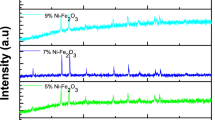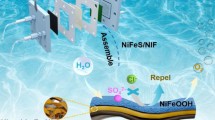Abstract
Urea-assisted hydrogen evolution is a promising alternative to conventional water splitting for producing hydrogen with reduced energy consumption. Therefore, the development of bifunctional electrocatalysts to be used in urine-mediated electrolyzers for the hydrogen evolution reaction (HER) and urea oxidation reaction (UOR) is required. In this work, nitrogen-doped iron phosphorus trisulfide (FePS3) nanosheets were prepared, which performance surpassed platinum on carbon electrocatalysts at large current densities above 140 mA cm−2, exhibiting excellent HER performance. A low overpotential of 756 mV was observed for UOR to drive a current density of 10 mA cm−2. When configured for hydrogen production, the urea electrolysis cell delivered a current density of 10 mA cm−2 at a cell voltage of 1.26 V, which is about 0.28 V lower than in conventional water electrolysis. The development of FePS3-based materials as bifunctional electrocatalysts provides a new approach enabling energy-saving hydrogen production.






Similar content being viewed by others
References
Zhang L, Han L, Liu H, Liu X, Luo J (2017) Potential-cycling synthesis of single platinum atoms for efficient hydrogen evolution in neutral media. Angew Chem Int Ed 56:13694–13698
Liu X, He J, Zhao S, Liu Y, Zhao Z, Luo J, Hu G, Sun X, Ding Y (2018) Self-powered H2 production with bifunctional hydrazine as sole consumable. Nat Commun 9:4365
Ďurovič M, Hnát J, Bouzek K (2021) Electrocatalysts for the hydrogen evolution reaction in alkaline and neutral media. A comparative review. J Power Sources 493:229708
Mahmood N, Yao Y, Zhang J-W, Pan L, Zhang X, Zou J-J (2018) Electrocatalysts for hydrogen evolution in alkaline electrolytes: mechanisms, challenges, and prospective solutions. Adv Sci 5:1700464
Li T, Luo G, Liu K, Li X, Sun D, Xu L, Li Y, Tang Y (2018) Encapsulation of Ni3Fe nanoparticles in N-doped carbon nanotube–grafted carbon nanofibers as high-efficiency hydrogen evolution electrocatalysts. Adv Funct Mater 28:1805828
Wang Y, Zheng X, Wang D (2022) Design concept for electrocatalysts. Nano Res 15:1730–1752
Cui Y, Guo X, Zhang J, Li X, Zhu X, Huang W (2022) Di-defects synergy boost electrocatalysis hydrogen evolution over two-dimensional heterojunctions. Nano Res 15:677–684
Jamesh M-I, Harb M (2021) Tuning the electronic structure of the earth-abundant electrocatalysts for oxygen evolution reaction (OER) to achieve efficient alkaline water splitting–A review. J Energy Chem 56:299–342
Peng X, Hou J, Mi Y, Sun J, Qi G, Qin Y, Zhang S, Qiu Y, Luo J, Liu X (2021) Bifunctional single-atomic Mn sites for energy-efficient hydrogen production. Nanoscale 13:4767–4773
Lu F, Zhou M, Zhou Y, Zeng X (2017) First-row transition metal-based catalysts for the oxygen evolution reaction under alkaline conditions: basic principles and recent advances. Small 13:1701931
Jiao Y, Zheng Y, Jaroniec M, Qiao SZ (2015) Design of electrocatalysts for oxygen-and hydrogen-involving energy conversion reactions. Chem Soc Rev 44:2060–2086
Lu Q, Yu Y, Ma Q, Chen B, Zhang H (2016) 2D transition-metal-dichalcogenide-nanosheet-based composites for photocatalytic and electrocatalytic hydrogen evolution reactions. Adv Mater 28:1917–1933
Sun H, Zhang W, Li J-G, Li Z, Ao X, Xue K-H, Ostrikov KK, Tang J, Wang C (2021) Rh-engineered ultrathin NiFe-LDH nanosheets enable highly-efficient overall water splitting and urea electrolysis. Appl Catal B: Environ 284:119740
Ojha K, Farber EM, Burshtein TY, Eisenberg D (2018) A multi-doped electrocatalyst for efficient hydrazine oxidation. Angew Chem Int Ed 57:17168–17172
Liu Y, Hu B, Wu S, Wang M, Zhang Z, Cui B, He L, Du M (2019) Hierarchical nanocomposite electrocatalyst of bimetallic zeolitic imidazolate framework and MoS2 sheets for non-Pt methanol oxidation and water splitting. Appl Catal B: Environ 258:117970
Zhu B, Liang Z, Zou R (2020) Designing advanced catalysts for energy conversion based on urea oxidation reaction. Small 16:1906133
Zhang L, Wang L, Lin H, Liu Y, Ye J, Wen Y, Chen A, Wang L, Ni F, Zhou Z (2019) A lattice-oxygen-involved reaction pathway to boost urea oxidation. Angew Chem Int Ed 18:16820–16825
Zhang J-Y, He T, Wang M, Qi R, Yan Y, Dong Z, Liu H, Wang H, Xia BY (2019) Energy-saving hydrogen production coupling urea oxidation over a bifunctional nickel-molybdenum nanotube array. Nano Energy 60:894–902
Wang Z, Liu W, Hu Y, Guan M, Xu L, Li H, Bao J, Li H (2020) Cr-doped CoFe layered double hydroxides: Highly efficient and robust bifunctional electrocatalyst for the oxidation of water and urea. Appl Catal B: Environ 272:118959
Zhang Q, Kazim FM, Ma S, Qu K, Li M, Wang Y, Hu H, Cai W, Yang Z (2021) Nitrogen dopants in nickel nanoparticles embedded carbon nanotubes promote overall urea oxidation. Appl Catal B: Environ 280:119436
Pu Z, Liu T, Amiinu IS, Cheng R, Wang P, Zhang C, Ji P, Hu W, Liu J, Mu S (2020) Transition-metal phosphides: activity origin, energy-related electrocatalysis applications, and synthetic strategies. Adv Funct Mater 30:2004009
Shi Z, Yang W, Gu Y, Liao T, Sun Z (2020) Metal-nitrogen-doped carbon materials as highly efficient catalysts: progress and rational design. Adv Sci 7:2001069
Chen Z, Duan X, Wei W, Wang S, Ni B-J (2019) Recent advances in transition metal-based electrocatalysts for alkaline hydrogen evolution. J Mater Chem A 7:14971–15005
Zhang X-Y, Yu W-L, Zhao J, Dong B, Liu C-G, Chai Y-M (2021) Recent development on self-supported transition metal-based catalysts for water electrolysis at large current density. Appl Mater Today 22:100913
Anantharaj S, Aravindan V (2020) Developments and perspectives in 3d transition-metal-based electrocatalysts for neutral and near-neutral water electrolysis. Adv Energy Mater 10:1902666
Song B, Li K, Yin Y, Wu T, Dang L, Cabán-Acevedo M, Han J, Gao T, Wang X, Zhang Z, Schmidt JR, Xu P, Jin S (2017) Tuning mixed nickel iron phosphosulfide nanosheet electrocatalysts for enhanced hydrogen and oxygen evolution. ACS Catal 7:8549–8557
Wang S, Xiao B, Shen S, Song K, Lin Z, Wang Z, Chen Y, Zhong W (2020) Cobalt doping of FePS3 promotes intrinsic active sites for the efficient hydrogen evolution reaction. Nanoscale 12:14459–14464
Chang J, Wang G, Belharsa A, Ge J, Xing W, Yang Y (2020) Stable Fe2P2S6 nanocrystal catalyst for high-efficiency water electrolysis. Small Methods 4:1900632
Zhu W, Gan W, Muhammad Z, Wang C, Wu C, Liu H, Liu D, Zhang K, He Q, Jiang H, Zheng X, Sun Z, Chen S, Song L (2018) Exfoliation of ultrathin FePS3 layers as a promising electrocatalyst for the oxygen evolution reaction. Chem Commun 54:4481–4484
Cheng Z, Shifa TA, Wang F, Gao Y, He P, Zhang K, Jiang C, Liu Q, He J (2018) High-yield production of monolayer FePS3 quantum sheets via chemical exfoliation for efficient photocatalytic hydrogen evolution. Adv Mater 30:1707433
Hongzhiwei Technology, Device Studio, Version 2021B, China, 2021. Available online: https://iresearch.net.cn/cloudSoftware (accessed on Feb. 2022)
Blöchl PE (1994) Projector augmented-wave method. Physical review B 24:17953
Huang H, Li F, Xue Q, Zhang Y, Yin S, Chen Y (2019) Salt-Templated construction of ultrathin cobalt doped iron thiophosphite nanosheets toward electrochemical ammonia synthesis. Small 15:1903500
Liu Z, Zhang C, Liu H, Feng L (2020) Efficient synergism of NiSe2 nanoparticle/NiO nanosheet for energy-relevant water and urea electrocatalysis. Appl Catal B: Environ 276:119165
Liu H, Peng X, Liu X, Qi G, Luo J (2019) Porous Mn-Doped FeP/Co3 (PO4)2 nanosheets as efficient electrocatalysts for overall water splitting in a wide pH range. Chemsuschem 12:1334–1341
Liu X, Xi W, Li C, Li X, Shi J, Shen Y, He J, Zhang L, Xie L, Sun X, Wang P, Luo J, Liu LM, Ding Y (2018) Nanoporous Zn-doped Co3O4 sheets with single-unit-cell-wide lateral surfaces for efficient oxygen evolution and water splitting. Nano Energy 44:371–377
Zhou Q, Shen Z, Zhu C, Li J, Ding Z, Wang P, Pan F, Zhang Z, Ma H, Wang S (2018) Nitrogen-doped CoP electrocatalysts for coupled hydrogen evolution and sulfur generation with low energy consumption. Adv Mater 30:1800140
Liu D, Liu T, Zhang L, Qu F, Du G, Asiri AM, Sun X (2017) High-performance urea electrolysis towards less energy-intensive electrochemical hydrogen production using a bifunctional catalyst electrode. J Mater Chem A 5:3208–3213
Fan H, Yu H, Zhang Y, Zheng Y, Luo Y, Dai Z, Li B, Zong Y, Yan Q (2017) Fe-doped Ni3C nanodots in N-doped carbon nanosheets for efficient hydrogen-evolution and oxygen-evolution electrocatalysis. Angew Chem Int Ed 56:12566–12570
Shinagawa T, Garcia-Esparza AT, Takanabe K (2015) Insight on Tafel slopes from a microkinetic analysis of aqueous electrocatalysis for energy conversion. Sci Rep 5:13801
Liu H, Peng X, Liu X (2018) Single-atom catalysts for the hydrogen evolution reaction. ChemElectroChem 5:2963–2974
H Jiang, M Sun, S Wu, B Huang, C Lee, W Zhang (2021) Oxygen‐incorporated NiMoP nanotube arrays as efficient bifunctional electrocatalysts for urea‐assisted energy‐saving hydrogen production in alkaline electrolyte, Adv Funct Mater 2104951
Acknowledgements
We are grateful for the HZWTECH for providing computation facilities.
Funding
This study was financially supported by the National Natural Science Foundation of China (22075211, 21601136, 51971157, 62005173, and 51621003).
Author information
Authors and Affiliations
Corresponding authors
Ethics declarations
Conflict of interest
The authors declare no competing interests.
Additional information
Publisher's note
Springer Nature remains neutral with regard to jurisdictional claims in published maps and institutional affiliations.
Supplementary Information
Below is the link to the electronic supplementary material.
Rights and permissions
About this article
Cite this article
Zhang, H., Qiu, Y., Zhang, S. et al. Nitrogen-incorporated iron phosphosulfide nanosheets as efficient bifunctional electrocatalysts for energy-saving hydrogen evolution. Ionics 28, 3927–3934 (2022). https://doi.org/10.1007/s11581-022-04634-z
Received:
Accepted:
Published:
Issue Date:
DOI: https://doi.org/10.1007/s11581-022-04634-z




